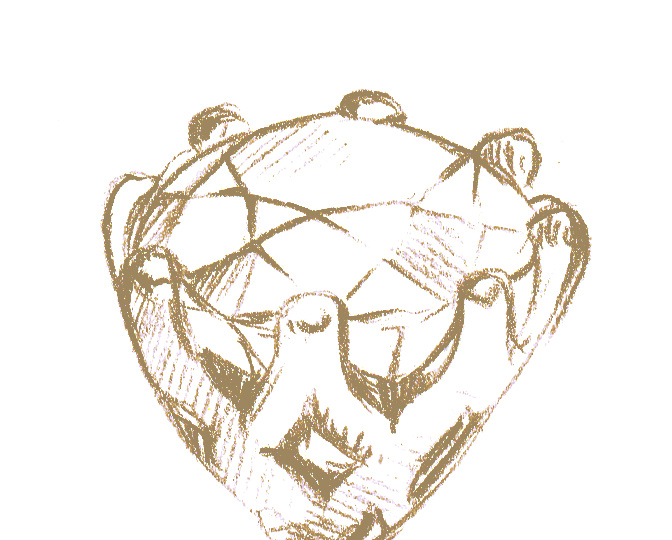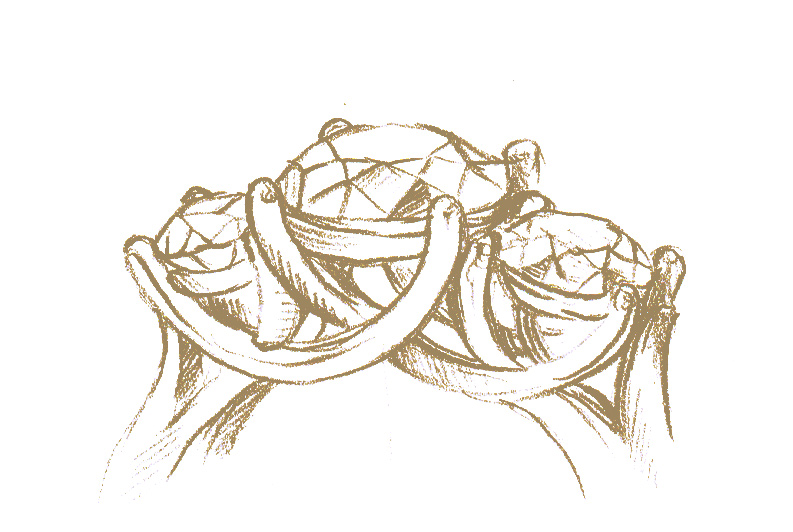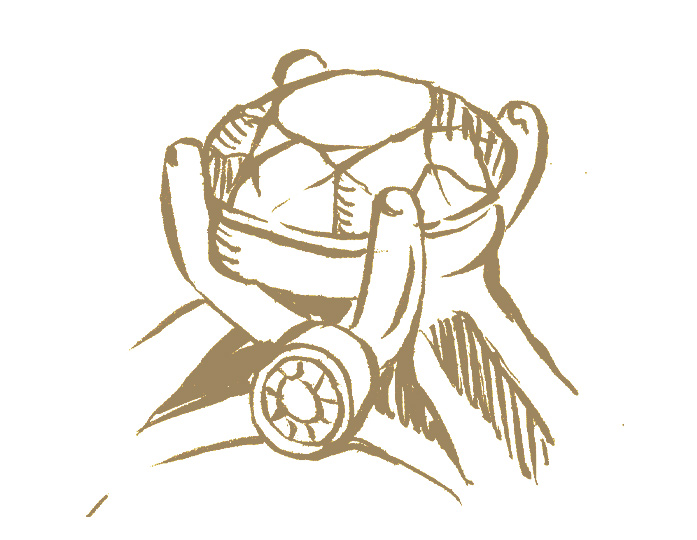Anatomy of a Ring: A Detailed Exploration of Ring Anatomy
January 11th, 2024 / Alese Oldenburg
In the mesmerizing world of engagement rings, certain elements effortlessly seize attention – the radiant diamond and the gracefully adorned band. These conspicuous features, however, only scratch the surface of a ring’s enchantment. Beyond the initial allure lies a realm of intricate details and symbolic elements, each contributing to the essence of this cherished piece of jewelry. The captivating sparkle of the diamond and the band’s symbolic representation of unity is merely the tip of the iceberg in a grand tapestry of design and emotion. Interested in unraveling the mysteries that transform a ring from a beautiful ornament to a profound symbol of love and commitment?
Embark on an enlightening journey with us as we delve into the nuanced world of ring anatomy. Far beyond the superficial beauty, we will dissect the craftsmanship, explore the symbolism, and appreciate the artistry that transforms an assemblage of elements into a timeless representation of affection. Whether you are a jewelry enthusiast, a couple embarking on the journey of engagement, or simply intrigued by the artistry behind these symbols of commitment, join us in this exploration. Together, we will uncover the secrets, nuances, and skilled craftsmanship that render an engagement ring not just a piece of jewelry but a profound expression of everlasting love.
Significance of Ring Anatomy
Selecting an engagement ring is more than just a momentary decision; it’s an investment in a symbol that’s meant to endure through a lifetime. At the heart of making an informed and lasting choice lies the understanding of ring anatomy. Like a delicate sliver engagement ring nestled in an accented setting, the intricate details matter. We firmly believe that knowledge is key, and the more you comprehend the anatomy of a ring, the more empowered you become in choosing a ring that resonates with your unique story.

Engagement rings are not just accessories; they are tangible representations of enduring love and commitment. Every facet, from the choice of metal and setting to the 4Cs of the diamond, contributes to the narrative of your relationship. The importance of ring anatomy extends beyond aesthetics; it plays a pivotal role in the longevity and emotional resonance of this cherished piece of jewelry. By delving into the intricacies of ring anatomy, you embark on a journey that empowers you to make a choice that aligns seamlessly with the depth and uniqueness of your love story. Understanding the anatomy of a ring is not merely about picking a beautiful ornament; it’s about selecting a timeless symbol that reflects the essence of your enduring commitment.
The Parts of A Ring
Dive into the enchanting realm of ring craftsmanship as we unravel the distinct and intricate parts that collectively compose these symbols of love. From the understated elegance of the girdle to the hidden intricacies of the gallery, every component plays a crucial role in shaping the character and allure of a ring.
Center Stone

This is likely the part of a ring that you are most familiar with, especially as it relates to engagement rings, which are widely defined by a center diamond. The center stone doesn’t have to be a diamond, though. In fact, when it comes to the best stones for engagement rings, there are many options to choose from. Some favorites for engagement rings and other fine jewelry include moissanite, sapphire, and emerald. All of these beautiful gemstones, and others still, will stand out on any hand and capture the attention a center stone warrants.
Ring’s Head

The head of the ring is what holds onto the center stone. There are multiple types of heads to choose from when it comes to ring design including a prong head, channel head, basket head, or bezel. Pronged heads are the most popular option. They are made up of a number of prongs that extend from the band and act as claws on the center stone to hold it in place.
Channel heads are made up of two straight pieces of metal that the stone is set between. A bezel is a type of head that encircles the center stone in metal. In fact, the bezel setting is the most secure of the types of heads.
Prong
A prong is a piece of metal that holds the gemstone in place, but it never works alone. While the number of prongs used to hold stones in place varies depending on the prong setting, the more prongs there are, the more secure the stone. However, the more prongs, the more the edges of the stone are covered as well. For example, solitaire engagement ring settings typically have four to six prongs.
Because this is the part of a ring that secures the stone, it’s important to ensure the prongs of a diamond ring are strong. To do so, you can pay attention to any wear and tear you notice the prongs experiencing and have a jeweler regularly check the prongs when you bring your ring in for cleaning.
There are various styles of prongs, dot prongs, and claw prongs being the most popular. Prongs can also vary in metal. Where gold prongs may be used to match a gold band, white gold or platinum prongs can disappear on a colorless diamond, and even make it appear larger.

Girdle
The girdle is a band that encircles the diamond across its widest part, separating the crown of the diamond (the part you see when you’re looking down at a ring) from the pavilion of the diamond (the part that points down toward your finger). From the side, the girdle appears like a line cutting across the middle of the stone.

Girdles can vary in thickness from “extremely thin”, to “very thin”, “thin”, “thick”, “slightly thick”, “very thick”, and “extremely thick”. When shopping for an engagement ring, the thickness of the girdle only really matters as it relates to your personal style, as long as you avoid “extremely thin” girdles, which can easily chip and leave the center stone vulnerable, and “extremely thick” girdles, which can limit the amount of light return (read: sparkle) of the center stone.
It’s also important to note that thicker girdles may suggest that a stone’s carat weight is hiding in its depth. When you purchase a diamond of a certain carat weight, you want most of that weight to be concentrated on the diamond’s table, which is the portion of the stone you will see when looking at the ring.
Shoulder
The shoulder of a ring, situated beneath the head like human shoulders, is a subtle yet crucial element. Serving as a seamless connection between the band and the setting, the shoulder enhances the ring’s aesthetic appeal and structural integrity. This versatile space often accommodates side stones or accent stones, adding a personalized touch to the ring’s design. Beyond its decorative role, the shoulder plays a vital part in ensuring the overall stability of the ring, making it an artful and functional component in the intricate dance of ring design.
Side Stones
Side stones are smaller diamonds or gemstones that flank the sides of the center stone. One of the most common settings for engagement rings is a three-stone setting, where there is a side stone on either side of the center stone. Side stones can enhance the overall brilliance of a ring, as well as its uniqueness, especially if they are a fancy cut or color. Of course, not all rings have smaller stones surrounding the brilliant center stone.
Halo settings are another way to enhance a center stone’s brilliance. This setting consists of several small diamonds that surround the center stone, diamond or otherwise, like a halo would surround a head.
A diamond band is yet another way to enhance the sparkle of your engagement ring without side stones. Consider a pave setting, which consists of numerous diamonds connected by tiny prongs or drops of metal.

Gallery
The gallery is the area directly beneath the center stone or stones of a ring. In most diamond engagement rings, the center stone is set higher above the finger to allow space for the depth of the stone, especially if the stone is of a large carat weight. This space that connects the setting of the stones with the band is part of the gallery. It can be simple in design or complex, consisting of metalwork, engraving, and/or accent stones, making it a beautiful place to incorporate a custom design.
The more delicate the gallery, the more delicate the ring. This is the part of the ring that connects the all-important center stones to the band. It can be prone to capture dirt and require regular cleaning, and it can also be prone to damage from friction when rings are stacked next to it.
Not all rings have galleries. Some rings such as simple metal bands lie flat against the skin. Other galleries can be open, which is common in classic designs, offering greater visibility of the depth of the diamond.

Shank
The shank is the metal band that makes a ring a ring. This is also the part that is altered to match your ring size. The shank can be made of various types of metal and in various widths. Popular metals for engagement rings include yellow gold, rose gold, white gold, and platinum, of which platinum is the strongest and 18K yellow gold is the weakest. When selecting the metal and width of your ring’s shank, or band, it’s important to know that thicker bands made of stronger materials will experience less wear over their lifetime, while thin bands made of weaker materials may need maintenance years down the line.

Hallmark
The hallmark of a ring is the small imprint on the inside of the band. This states the composition and value of the precious metal and is required for all jewelry. For gold rings, the hallmark is typically “14K” or “18K” to signify the type of gold, whereas, for platinum rings, the hallmark can be “platinum”, “PT”, or “Plat”. A hallmark may also often include the manufacturer’s stamp or logo.
Just as the hallmark is engraved into the band, or shank, of a ring, an inscription can also be engraved into your engagement ring or wedding band. This is a unique option to customize or personalize your rings for added sentimental value.

Discover Your Dream Ring
Now armed with a comprehensive understanding of the various components that constitute a ring, your quest for the perfect engagement ring or fine jewelry piece takes on a newfound significance. This knowledge equips you with the discerning eye needed to navigate the diverse landscape of styles, settings, and metals. Whether you opt for the bespoke journey of creating a custom ring that aligns with your unique vision or decide to explore curated designs, your awareness of each nuanced part allows you to inspect and appreciate every detail of a diamond ring setting with finesse.
As you delve into the world of exquisite rings, your informed perspective not only enhances your ability to make aesthetic decisions but also enables you to appreciate the craftsmanship and symbolism woven into each element. Whether you’re drawn to the timeless simplicity of a classic solitaire or the intricate details of a custom-designed masterpiece, your dream ring beckons, ready to become a treasured symbol of your enduring love and personal style. Your journey to discover the perfect ring becomes a personalized exploration, guided by a profound understanding of the intricate details that make each piece as unique as the love story it represents.
sources
https://www.gemsociety.org/article/diamond-girdles/
https://www.mygemologist.com/learn/general-info/anatomy-of-a-ring/
*Here at Diamond Nexus, we strive to provide valuable information while being clear and honest about our products. The Nexus Diamond™ alternative is a patented lab created diamond simulate that, among all simulants, most closely imitates the look, weight and wear of a diamond, with two exceptions – it is absolutely perfect in every way, and it costs significantly less. Price points and environmental facts expressed in this blog were taken from popular online retailers and may vary. Learn more about the environmental impact of mining by visiting our blog.

